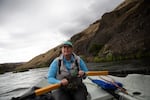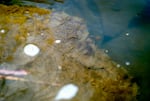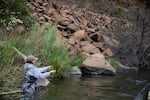
Fishing guide Amy Hazel rows a drift boat on the lower Deschutes River near Maupin, Ore., June 17, 2022. She's been guiding on the river since 1999.
Bradley W. Parks / OPB
Fishing guide Amy Hazel gripped the oars, leaned back and pulled her drift boat across the tumbling waters of the lower Deschutes River as cheesecloth clouds filtered sunlight on a Friday in June.
She had her eyes set on an eddy where she knew she’d find fish inclined to munch on a dry fly.
“It’s a hunt,” Hazel said. “It’s not a game of numbers, unless you want to make it a game of numbers, and then you wouldn’t be necessarily always doing what we’re doing, which is targeting one fish at a time. … I like the hunt.”
Dry-fly fishing, in which anglers use lures that stay above the surface of the water, requires incredible precision — and optimal conditions.

Amy Hazel searches for the right mayfly. Different flies hatch at different times of the day in different times of the year, so the fly she picks depends on what's flying around and what a fish is most likely to eat.
Bradley W. Parks / OPB
Fishermen have long flocked to the lower Deschutes, which flows north from the Pelton Round Butte dams near Madras all the way to the Columbia, to pursue trout and steelhead with dry flies.
But water quality on the lower river has taken a turn for the worse in recent years, threatening the world-class fisheries that have supported Hazel’s fly shop, the Deschutes Angler, and others in the town of Maupin, population 387.
“I’ve lost lots of clients to Montana. I’ve lost lots of clients to other places where people can go where they can still dry-fly fish,” Hazel said. “You can’t have that amazing dry-fly fishing experience day in and day out on the Deschutes like we once were able to have.”
Related: OPB survey: What water issues concern you most?
Hazel started guiding on the lower river in 1999, and she fondly recalls the kaleidoscopic rock colors under the cold, clean water. Picking out the fish she was going to catch was a lot easier back then when she could see them surfing the currents.
Now, standing hip-deep in the river, Hazel reached down to pick up a rock on the riverbank. She ran a finger through a gooey, greenish-gray layer of algae coating the stone’s sun-facing side. “Pretty gross,” Hazel said.
Nuisance algae has proliferated on the lower Deschutes. It’s one of the most visible signs of the waterway’s declining health.

Nuisance algae coats rocks on the banks of the lower Deschutes River near Maupin, Ore. Water quality changes in recent years have contributed to a proliferation of the algae, making wading treacherous and damaging the fishery.
Bradley W. Parks / OPB
The conservation group Deschutes River Alliance, of which Hazel is a founding member, says some of the river’s health issues stem from operations at a $110 million water-mixing tower behind Round Butte Dam in Lake Billy Chinook.
Portland General Electric and the Confederated Tribes of the Warm Springs Indian Reservation, which own and operate the dams together, installed the tower in 2009 to improve fish passage and regulate water temperatures on the lower Deschutes.
PGE says that, since the tower was installed, adult steelhead, Chinook salmon and sockeye salmon have been able to access 250 miles of habitat that had been blocked since the 1960s.
“Together, as co-owners and co-operators of the Pelton Round Butte Project, PGE and the CTWS continue to work alongside numerous stakeholders to protect water quality, enhance habitat and restore sustainable populations of salmon and steelhead to the Deschutes River,” PGE spokesperson John Farmer said in an email.
Lake Billy Chinook forms at the confluence of the Crooked, Deschutes and Metolius rivers. Colder, cleaner water from the Metolius sinks to the bottom while warmer, more polluted water from the Crooked rises to the top.
Before the tower was installed, Lake Billy Chinook had just one outlet at the bottom of the reservoir. That meant most of the water entering the lower Deschutes, especially earlier in the spring and summer, was a cold blast of Metolius water until it ran out.
The tower has two outlets and sends a mix of water into the lower Deschutes, making the water slightly warmer in the spring and cooler in the fall than before. PGE says this mix “more closely matches seasonal patterns we’d expect to see without the dams’ presence.”
The Deschutes River Alliance, on the other hand, says the warmer water is destroying the lower river, contributing to black spot disease in fish, and eliminating a crucial cold-water refuge on the Columbia.
The group has lodged water quality complaints and even led a Clean Water Act lawsuit against PGE and the tribes. The lawsuit accused the operators of violating standards for pH, dissolved oxygen and temperature more than 1,200 times from 2009 to 2016. The suit was dismissed due to the tribes’ sovereign immunity.
The Oregon Department of Environmental Quality says PGE and the tribes are in full compliance with their operating permits and that the tower may not be the sole cause of water quality issues on the river.
Hazel says watching water quality deteriorate on the lower Deschutes and springs dry up elsewhere in Oregon has reminded her of the river’s fragility.

Cece Cole casts a line on the banks of the lower Deschutes River near Maupin, Ore., on June 17, 2022.
Bradley W. Parks / OPB
Hazel and her intern Cece Cole came up empty on their trip down the river last month. But after decades of fishing and guiding, Hazel says she doesn’t need to catch fish to have a good day on the lower Deschutes.
Still, she’s determined to try to preserve dry-fly fishing for others, but it’s far from the only reason she fights for the river.
“If the cold water is gone, " Hazel said, “we’d have a lot more things to worry about than if we’re going to catch a rainbow trout on a dry fly.”
Someone online gave Hazel the nickname “the Second Mouth of the Deschutes” for her vocal defense of the river. It’s a moniker she’s come to embrace.
“Most rivers have just one mouth,” she said. “I’m happy to be a person to speak up for the river. I’m not gonna sit back and not say anything when my river is threatened.”
How would you describe your relationship with water? OPB environment reporter Bradley W. Parks is covering drought and water shortages in Central and Eastern Oregon. Email bparks@opb.org.



